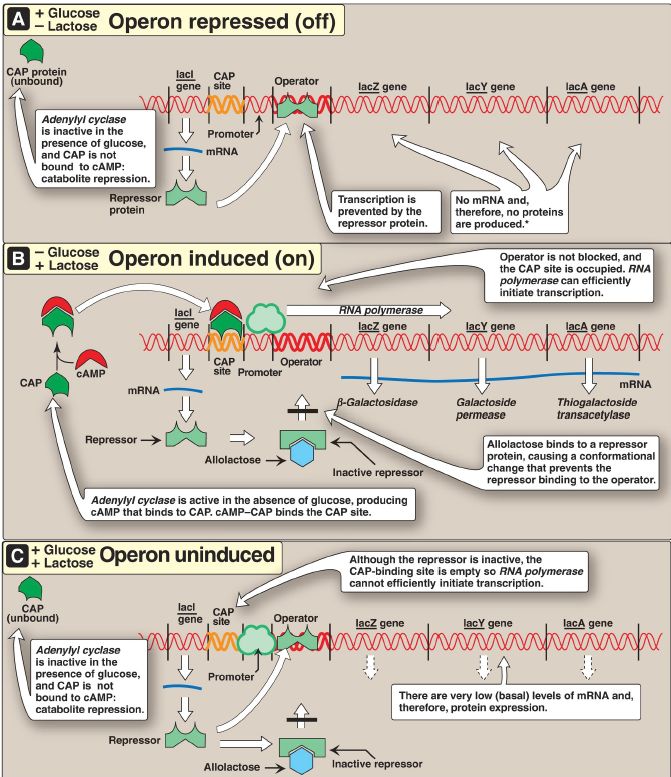


 النبات
النبات
 الحيوان
الحيوان
 الأحياء المجهرية
الأحياء المجهرية
 علم الأمراض
علم الأمراض
 التقانة الإحيائية
التقانة الإحيائية
 التقنية الحيوية المكروبية
التقنية الحيوية المكروبية
 التقنية الحياتية النانوية
التقنية الحياتية النانوية
 علم الأجنة
علم الأجنة
 الأحياء الجزيئي
الأحياء الجزيئي
 علم وظائف الأعضاء
علم وظائف الأعضاء
 الغدد
الغدد
 المضادات الحيوية
المضادات الحيوية| Regulation of Prokaryotic Gene Expression: Operators in bacterial operons |
|
|
|
Read More
Date: 2-9-2021
Date: 2-11-2021
Date: 26-12-2021
|
Regulation of Prokaryotic Gene Expression: Operators in bacterial operons
Bacterial operons contain an operator, a segment of DNA that regulates the activity of the structural genes of the operon by reversibly binding a protein known as the repressor. If the operator is not bound by the repressor, RNA polymerase (RNA pol) binds the promoter, passes over the operator, and reaches the protein-coding genes that it transcribes to mRNA. If the repressor is bound to the operator, the polymerase is blocked and does not produce mRNA. As long as the repressor is bound to the operator, no mRNA (and, therefore, no proteins) are made. However, when an inducer molecule is present, it binds to the repressor, causing the repressor to change shape so that it no longer binds the operator. When this happens, RNA pol can initiate transcription. One of the best-understood examples is the inducible lactose (lac) operon of E. coli that illustrates both positive and negative regulation (Fig. 1).

Figure 1: The lactose operon of Escherichia coli in the presence of A. only glucose, B. only lactose, and C. both sugars. *[Note: Even when the operon has been turned off, the repressor transiently dissociates from the operator at a slow rate, allowing a very low level of expression. The synthesis of a few molecules of permease (and β-galactosidase) allows the organism to respond rapidly should glucose become unavailable.] CAP = catabolite activator protein; cAMP = cyclic adenosine monophosphate; mRNA = messenger RNA.



|
|
|
|
دخلت غرفة فنسيت ماذا تريد من داخلها.. خبير يفسر الحالة
|
|
|
|
|
|
|
ثورة طبية.. ابتكار أصغر جهاز لتنظيم ضربات القلب في العالم
|
|
|
|
|
|
|
سماحة السيد الصافي يؤكد ضرورة تعريف المجتمعات بأهمية مبادئ أهل البيت (عليهم السلام) في إيجاد حلول للمشاكل الاجتماعية
|
|
|